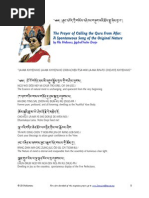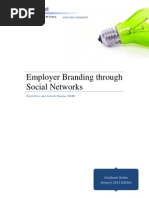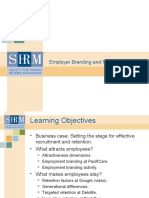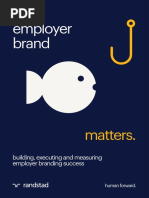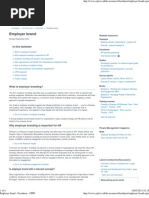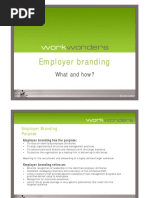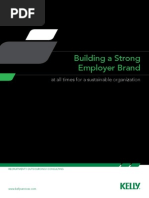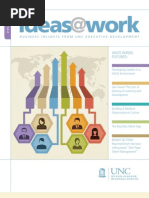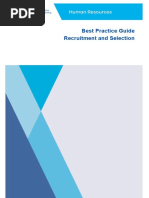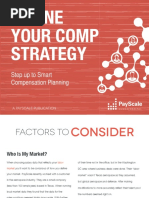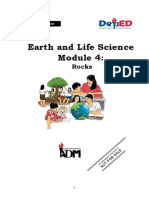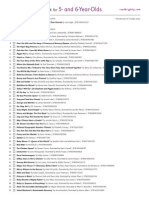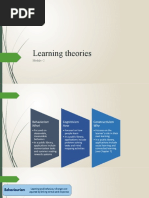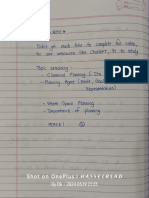Employer Brand Measurement
Employer Brand Measurement
Uploaded by
AlinaSaftaCopyright:
Available Formats
Employer Brand Measurement
Employer Brand Measurement
Uploaded by
AlinaSaftaOriginal Description:
Copyright
Available Formats
Share this document
Did you find this document useful?
Is this content inappropriate?
Copyright:
Available Formats
Employer Brand Measurement
Employer Brand Measurement
Uploaded by
AlinaSaftaCopyright:
Available Formats
Vision: The Journal
of Business Perspective
http://vis.sagepub.com/
Employer Brand for Talent Acquisition: An Exploration towards its Measurement
Pallavi Srivastava and Jyotsna Bhatnagar
Vision: The Journal of Business Perspective 2010 14: 25
DOI: 10.1177/097226291001400103
The online version of this article can be found at:
http://vis.sagepub.com/content/14/1-2/25
Published by:
http://www.sagepublications.com
On behalf of:
Management Development Institute
Additional services and information for Vision: The Journal of Business Perspective can be found at:
Email Alerts: http://vis.sagepub.com/cgi/alerts
Subscriptions: http://vis.sagepub.com/subscriptions
Reprints: http://www.sagepub.com/journalsReprints.nav
Permissions: http://www.sagepub.com/journalsPermissions.nav
Citations: http://vis.sagepub.com/content/14/1-2/25.refs.html
>> Version of Record - Jan 1, 2010
What is This?
Downloaded from vis.sagepub.com by Mara Serban on October 26, 2011
EMPLOYER BRAND FOR TALENT ACQUISITION:
AN EXPLORATION TOWARDS ITS MEASUREMENT
Pallavi Srivastava and Jyotsna Bhatnagar
This paper addresses the concerns associated with talent acquisition and how employer brand can overcome
some of them. Based on the literature review and supported with the first stage sequential mixed method
exploratory research, the paper summarises and aggregates the results of a pilot study conducted on a
section ofprospective employees ofIndia. The study contributes to the sparse academic and empirical work
on employer branding. The empirical results are initial steps towards the development ofa scale for measuring
employer brand in a later stage. The current study willfurther facilitate development ofthe unique employee
value proposition based on the person-need fit of talent. The research is based in an Indian setting which
makes it all the more relevant in current economic scenario. The paper concludes with theoretical and
practical implications followed by directions for the future research.
Key Words: Employer Brand, Staffing, Talent Acquisition, India
INTRODUCTION
he current business environment is marked with
challenges of intense global competition, rapid
technological changes, growth of the knowledge
economy, and the need for flexibility and expertise in
the workplace (Catteeuw et al., 2007; Wickham and
O'Donohue, 2009). This has resulted in the changing skills
and competency requirements. Concomitantly, due to the
pressures of a changing demographic base, the demand
for intellectual capital-a cadre of highly skilled,
independent, internationally marketable and mobile
individuals-is exceeding the available supply (Ewing
et al., 2002; Ployhart, 2006). The tight labour market
gives highly competent employees many choices
(Srivastava and Bhatnagar, 2008) especially in
professional, information / knowledge based, technical
and service driven organisations (Ewing et al., 2002).
Prospective employees are as particular about choosing
the right organisation as about choosing the right job
(Rynes and Cable; 2003). Hence, organisations are
increasingly trying to assess and enhance their
attractiveness to prospective applicants (Highhouse et al.,
1999). This has critical consequences for the recruiting
organisations (Rynes, 1991) as it leads to the most
pressing problem of talent acquisition- of attracting
people with the right skill set and competencies who also
fit the need and the culture of the organisation (Bhatnagar
and Srivastava, 2008). Organisations that attract a larger
applicant pool and more qualified applicants obtain
greater utility in their selection systems (Boudreau and
Rynes, 1985) and a potential competitive advantage (Lado
and Wilson, 1994).
India, one of the world's largest economies, has
made giant leap in its economic and social development
in the past two decades and has proven itself to be a major
economic and intellectual power (Kapur and Ramamurti,
2001). It is the major source ofthe world's largest English
speaking low cost workforce, with a high level technical
and managerial talent fuelled by world-class institutes in
India like Indian Institute ofTechnology (IITs) and Indian
Institute of Management (IIMs). Being industrious, hard
working and focused on merit based and education
dependent advance, Indian human skills are in great
demand (Nath, 2008). Indian workforce is most sought
Downloaded from vis.sagepub.com by Mara Serban on October 26, 2011
26 Srivastava and Bhatnagar
after by the multinational giants because of the global
recognition of its people, their management capabilities
and innovativeness. This has resulted in a large number
of Indians finding place in the payrolls of different
multinationals. The availability of new jobs for the Indian
talent resulting in a higher turnover (Budhwar et al.,
2006), has made the organisations to sit back and revamp
their recruitment strategy to attract and retain the top
talent.
A consequence of the anticipated permanent
shortage of competent workforce referred above is the
need for a strong recruitment strategy after finding out
what differentiates the organisations from the competitors
and then market the unique employment proposition it
can offer (Ewing et al., 2002; Keefe, 2007). Employer
branding (Ambler and Barrow, 1996) is one such relevant
HR strategy in the context of employment, especially in
a knowledge based and service economy where
competent employees are often in short supply. Where
traditional recruitment strategies are short-term, reactive
and subject to job openings, employment branding is a
long-term strategy designed to maintain a steady flow of
skills in the organisation.
India, a hierarchical society, is considered to be high
in power distance and collectivism (Deshpande and
Farley, 1999). Earlier studies on similar studies on
employer brand have been conducted on Belgian army
(Lievens, 2007), university students in the U.K. (Knox
and Freeman, 2006) and Australia (Berthon et al., 2005)
etc, which differ from India on the cultural dimensions
(Hofstede and Hofstede, 2005). We propose that in India,
the factors that build up a strong employer brand,
attractive enough for its talent pool are different from
the other parts of the world as they differ in their cultural
and managerial environments. It is precisely these
differences that raise the issue of whether earlier research
on this subject is generalisable to India. Since the Indian
talent is in great demand globally, the multinational
organisations need to understand the perspective of an
Indian talent to develop their employee value proposition
accordingly. It is necessary to understand the dimensions
of employer brand in the Indian setting in order to help
the global organisations to model their recruitment
strategies for India.
EMPLOYER BRAND: A LITERATURE REVIEW
Employer branding has emerged from applying marketing
principles to the field of personnel recruitment (Maurer
et aI., 1992). Ambler and Barrow (1996) were among the
first ones to bring together the domains of Human
Resources Management and Brand Marketing into a
single conceptual area by coining the term employer
brand. Employer branding is a specific form of managing
corporate identities. It does so by creating both, within
and outside the firm, an image of the organisation in two
forms - first, as a distinct and desirable employer (Ambler
and Barrow, 1996; Backhaus and Tikoo, 2004) and
second, as a good place to work (Bergeron, 2001). The
various definitions of employer brand as given in
literature are summarised in Table 1.
Table 1: Some Definitions of Employer Brand as Found
in Literature
Ambler and Barrow
(1996: p.187)
"The package of functional, economic and
psychological benefi ts provided by
employment, and identified with the employing
company."
Ewing et al., (2002:
p.12)
"Building an image in the minds of the potential
labour market, that the company above all others,
is a great place to work."
Lloyd (2002) as cited
in Berthon et al.,
(2001: p.152)
"The sum ofa company's efforts to communicate
to existing and prospective staff that it is a
desirable place to work."
Backaus and Tikoo
(2004: p.502)
"Process of building an identifiable and unique
employer identity... concept of the firm that
differentiates it from its competitors."
Knox and Freeman
(2006: p.697)
"Image associated with an organisation,
uniquely in its role as an employer."
Kimpakom and
Tocquer(2009: p.534)
"An organisation's image as seen through the
eyes of its actual and potential employees."
To sum it up, we can say that an employer brand is
about giving an identity, image and distinctiveness to the
organisation as an employer in order to attract its
prospective employees and to motivate, engage and retain
its current employees.
Importance of Employer Brand
As in the initial stage of the decision making process the
information about the organisation is limited. Therefore
initial application decisions are heavily based on the
general impression of the attractiveness of the
organisation (Rynes, 1991). Any information that job
seekers view builds their impressions of the employer
organisation and can become cues for what it would be
like to work for it (Turban et al., 1998). Therefore
organisations have to make extra efforts to maintain their
image before the prospective applicants as an attractive
employer (Bergeron, 2001). When a firm reaches a higher
level of external recognition by developing an employer
brand, it becomes much easier for it to attract new talent
(Bouchikhi and Kimberly, 2008). It is an effective tool
for effective recruitment, employee engagement and
retention (Barrow and Mosley, 2005).
VISION-The Journal of Business Perspective Vol. 14 Nos. 1 & 2 January-June 2010
Downloaded from vis.sagepub.com by Mara Serban on October 26, 2011
Employer Brandfor Talent Acquisition: An Exploration towards its Measurement 27
The power of the employer brand has been rightly
summed up by Fernon (2008: p.50) as "its ability to
deliver organisational success by attracting and retaining
the right people, providing an environment in which
employees live the brand, improving organisational
performance in key business areas of recruitment,
retention, engagement and the bottom line and
differentiating employers from each other, creating
competitive advantage. "2
It is considered to benefit both individuals as well
as organisation (Bergeron, 2001). It provides a coherent
framework for management to simplify and focus
priorities, increase productivity and improve recruitment,
retention and commitment (Keefe, 2007; Ambler and
Barrow, 1996; Backhaus and Tikoo, 2004). From the
employees' point of view, being a member of an
organisation having a strong employer brand enhances
their self-esteem and strengthens their organisational
identification (Lievens et al., 2007). Constant delivery
of the brand promise leads to trust and loyalty ensuring a
steady supply of applicants (Holliday, 1997) and
maintains high commitment and high performance among
employees and ultimately organisational effectiveness by
promoting the organisation's credibility with employees
(Burack et al., 1994). It attracts the right kind of
candidates with the culture fit and at the same time gives
the prospective employees an assurance of the work
experience as expected by them (Bhatnagar and
Srivastava, 2008).
Employer branding communicates the unique
employment proposition of the organisation to
prospective hires, current employees and society at large
by creating, both within and outside the organisation, an
image of the organisation as a distinct and desirable
employer (Ambler and Barrow, 1996; Backhaus and
Tikoo, 2004; Balmer and Greyser, 2002) and as a good
place to work (Bergeron, 2001). It requires an employer
to identify what is unique and distinct about the
organisation relative to the competitors, marketing it to
the target population and ensuring that the applicants have
a clear idea of the employment value proposition
(Bergeron, 200 Ia). This helps differentiate organisations
from their competitors by creating a distinct image of
the total employment relationship and employee life cycle
management which the organisation offers to its
prospective and current employees, even when they
cannot compete in terms of location or wages (Ployhart,
2006).
There are two views on the development of an
Employment Value Proposition (EVP). While Rynes and
Barber (1990) suggested that organisations can
proactively mould selected organisational characteristics
as strategy to attract those considered most desirable,
other researchers saythat the purpose of the employer
brand is not to generate an entirely new set of values to
suit the expectations of the prospective employees but to
help ensure that the existing values are translated into
something consistent with the values the organisation
wishes to project externally (Ambler and Barrow, 1996;
Bergeron, 2001). It is about understanding what the
organisation has to offer and then conveying it to its target
applicants in such a way that it looks appealing and
differentiating from its competitors.
Process of Employer branding
Backhau and Tikoo (2004) identify three aspects of
employer branding process. First, an organisation
develops a clear, consistent and honest "value
proposition" based on research for their existing and
prospective staff (Heger, 2007) embodying the
organisation culture, the management style, qualities of
current employees, current employment image, and
impressions of products or service quality manager
(Sullivan, 2002), that clearly establishes who they are,
what they expect from employees and what they offer
(Lawler, 2005: p.I3). For this, the organisation should
understand the expectations of the prospective applicants
that the organisation needs and the specific attributes it
has which are found appealing by the applicants. It is
also important to find out what the competitors are
offering to the same pool of applicants. The EVP should
be built around this common theme which is yet different
from that of the competitors.
Then, the organisation uses it to attract the
prospective employees and thirdly lives up to the brand
promise made to the recruits (Lawler, 2005) for their
engagement and retention. The EVP must be in
accordance with the business strategy ofthe organisation,
so that the employer brand acts as a filter for only those
people who have the motivation, skills, knowledge,
competencies and personality to perform the required job
(ibid).
Constituents of Employer Brand
The employer brand is said to consist of many attributes
with each one strengthening the brand (Bergeron, 200 I).
Researchers have examined the factors that determine
VISION-The Journal of Business Perspective Vol. 14 Nos. 1 & 2 January-June 2010
Downloaded from vis.sagepub.com by Mara Serban on October 26, 2011
28 Srivastava and Bhatnagar
an organisation's employment image (Highhouse et al.,
1999; Cable and Turban, 2001). Using the instrumentalsymbolic framework, Lievens et al., (2007) examined the
factors which attract and connect employees (company
insiders) as well as applicants (company outsiders) to a
given organisation as an employer. Slaughter et al., (2008)
confirmed that symbolic attributes were related to
organisational attractiveness. While Lievens et al., (2005)
found the incremental variance of symbolic image
dimensions over and above instrumental image
components in explaining students' attraction to the Army,
Collins and Stevens (2002) established that companybased attributes had greater impact on job seekers than
role-specific attributes.
An exploration of the literature revealed little
research on theory development, scale development in
Employer Branding (Joo and Mclean, 2006; Moroko and
Uncles, 2008). There is also a scope for empirical research
on employer brand (Ewing et al., 2002; Berthon et al.,
2001) and its dimensions and establishing the impact of
an Employer brand on the attractiveness of an
organisation as an employer (Berthon et al., 2001). This
calls for another rigorous study on the subject adding to
the existing knowledge.
EMPLOYER BRAND IN AN INDIAN SETTING: AN
EXPLORATORY STUDY
An exploratory study was conducted among the
prospective employees of India meant for managerial
positions in different organisations, to find out the factors
of employer brand. The sample was taken from final year
postgraduate management students in the flagship
programme and working managers enrolled in the
executive management programme students of two
premiere Business schools located in the National Capital
Region of India. These business schools were among the
top ten management institutes of India according to
various B-school survey rankings.
Purpose of the Study
Most of the emphasis from the recruiting literature has
focused solely on organisations attracting prospective
employees (Rynes, 1993). However, it is also important
to understand how applicants view the hiring organisation
from the first impressions during the recruitment process.
The objective of this exploratory research was to
understand the underlying structure of employer brand
by identifying factors that represent an employer brand
by capturing the perspectives of prospective employees
of India.
Research Methodology
This study was conducted in two phases. A sequential
mixed-method approach was taken where qualitative data
analysis was followed by a quantitative approach. Phase
one consisted of item generation based on literature
review and an exploratory qualitative study. The
qualitative study comprised of several methods namely
open-ended questionnaire, semi-structured interviews,
focus groups discussions and content analysis of the main
page and career section of official websites of different
organisations, to identify the key variables that represent
the construct of employer brand. The second phase
comprised of scale development in the form of survey.
This paper focuses on the second phase of the research
work, and is only exploratory in nature which would help
in developing scale on employer brand to be tested later.
It attempts to establish the constituents of the employer
branding scale, which may be used for talent management
by the organisations. This research does not have any
explanatory features as it does not aim to test any causal
relationships.
Item Generation
The initial set of scale items was generated based on
insights from existing literature and from information
gained through qualitative study. Since employer brand
is a multidimensional construct (Bergeron, 2001 a) it
was not possible to study each and every aspect of it.
Hence we depended on the findings of our qualitative
research to narrow down on variables to be included
in our study. The content analysis of the qualitative
data resulted in thirty-nine variables out of which
eleven variables were chosen based on their
prominence in the study. It was found that some of
the job attributes given by Posner (1981), namely
opportunity to learn, "freedom to do the job my own
way," opportunity for rapid advancement, fringe
benefits, salary, reputation of company, training
programmes are common to our variables.
Based on the variables identified in the qualitative
study, items were generated for each of them. Some
were adopted / modified from established scales (as
given in Table 2). Two academic experts and two
research scholars assessed the content and face validity
of the survey measures and the items. Thus, a
questionnaire was constructed and pre-tested before a
group of 30 respondents. Thereafter, sampling
procedure, methods of data collection and analysis
were determined.
VISION-The Journal of Business Perspective Vol. 14 Nos. 1&2 January-June 2010
Downloaded from vis.sagepub.com by Mara Serban on October 26, 2011
Employer Brandfor Talent Acquisition: An Exploration towards its Measurement 29
Table 2: Scales Identified from Literature for the Purpose of Our Study
VARIABLE
SOURCE OF ITEMS
A SAMPLE OF ITEM
Financial Performance
Chun (2001)
(It) looks like a company with strong prospects for
future growth
Product / Service Brand
Chun (2001), Fombrun (1998), Cable
and Graham (2000)
It invests heavily in R &D (Fombrun, 1998)
Good Corporate Citizen
Chun (2001),
(2000)
and Graham
It talks about integrity which is high on my list. I
don't want to work for a company that doesn't value
integrity and morals, (Cable and Graham, 2000)
Word of Mouth
Cable and Graham (2000), Highhouse
et al., (1999), Lievens et al., (2005)
I have heard good things about working here
(Highhouse et al., 1999)
Industry / Sector Image
No relevant scale could be found
(Items developed were based on the qualitative study)
Autonomy
Lievens et al., (2005)
It is a good organisation to work if you like getting
orders (Lievens et al., 2005)
People-orientedness
Highhouse et al., (1999)
I would imagine they have flexible hours (Highhouse
et al., 1999)
Fun at Work
Karl et al., (2007), Lievens et al.,
(2005)
This is fun place to work (Karl et al., 2007)
Learning and Development
Fulmer et aI., (2003), Highhouse et
al., (1999)' Lievens et al., (2005)
Employees are offered training and development to
further themselves professionally (Fulmer et al.,
2003)
Career Growth
Cable and Graham (2000), Highhouse
et al., (1999), Lievens et al., (2005)
A job at this company may be a dead-end job (Cable
and Graham, 2000)
Reward Strategy
Lievens et al., (2005)
Working in ... (this organisation) provides you with a
good salary (Lievens et al., 2005)
Cable
Data Collection
Data for the survey was collected from a mix of 105 final
year postgraduate management students and working
managers enrolled in the executive management
programme students of two premiere Business schools
located in the National Capital Region of India. These
respondents were a sample representative of the
items in the questionnaire. Since familiarity with the
organisation was a relevant condition to assess the
perception about the employer brand in the questionnaire,
the respondents were asked to think of a familiar
organisation where they would like to pursue a career in
immediate future. Then they were asked to rate the various
attributes of the organisation based on their perception.
population of interest (Hinkin, 1995). A self administered
Among a total of 150 distributed questionnaires,
questionnaire consisting of 72 items was distributed in
the classes of both fulltime as well as executive
management students with permission from the instructor.
The questionnaire was based on a Likert 5-point scale
and the demographic variables were tapped through single
105 completed, usable questionnaires were collected and
resulted in the effective response rate of 70%. This is a
high response rate as questionnaires were to be filled in
the class itself. The demographic profile of the
respondents is given in Table 3.
VISION-The Journal of Business Perspective Vol. 14 Nos. 1 & 2 January-June 2010
Downloaded from vis.sagepub.com by Mara Serban on October 26, 2011
30 Srivastava and Bhatnagar
Table 3: Demographic Profile of Respondents
DEMOGRAPIllCS
1.
2.
3.
5.
27.6
20-25 years
26-30 years
28.6
31-35 years
25.5
36-40 years
11.2
7.1
Above 40 years
GENDER
Male
Female
79.6
80.4
QUALIFICATIONS
Ordinary Graduate
5.5
Technical Graduate
72.5
Ordinary Postgraduate
3.3
Professional Postgraduate
16.5
2.2
Others
The result showed a clear eight factor solution.
These factors with eigenvalues greater than one were
extracted from all the measures in this study and in total
accounted for 71.3% of the variance. The first factor
accounted for 18.6 % of the variance which falls below
50% level and indicates the lack of common method bias
(Podsakoff et al., 2003). Since a single factor did' not
emerge and one factor did not account for most of the
variance, this suggests that the results were not due to
common method variance. The Cronbach alpha in this
case was 0.73 which satisfied the above 0.70 criterion
(Nunnally, 1978). The factor analysis results and its
reliability are reported in Table 4 given hereafter.
Table 4: Factor Loadings and Reliability Analysis
Rotated Component Matrix
WORK EXPERIENCE
6.
Working Managers
56.9
43.1
Management Students
AGE
4.
PERCENTAGE
TYPE
any other factor. Out of a 72 item initial scale, 52 items
were eliminated from the initial measurement which left
20 items for subsequent analysis. To check whether
common method variance was present, we used Harmon's
one factor test (Podsakoff and Organ, 1986).
Nil
Less than 1 year
Component
15.2
12.4
Between 5 and 10 years
13.3
37.1
Above 10 years
21.9
Between 1 and 5 years
FAMILY INCOME
Less than Rs 5 lakhs p.a
42.1
Between Rs 5-10 lakhs p.a.
33.7
Between 10-15 lakhs p.a.
16.8
Between 15-20 lakhs p.a.
4.2
More than 20 lakhs p.a.
3.2
Data Analysis
Before applying factor analysis for data reduction, the
data corresponding to different constructs was subj ected
to a number of evaluative procedures. According to the
guidelines provided by De Vellis (1991), the data was
checked for internal consistency, item-total correlation,
variance, item means before proceeding for factor
analysis. A principle components analysis with varimax
rotation and a factor extraction according to the MINIEIGEN criterion (all eigen values above 1) with all items
in the survey was conducted. Factor loadings of minimum
0.50 were considered to meet the minimal level for
interpretation of factor structure. In order to construct an
employer brand scale with meaningful managerial
implications, only single-component items were included
in the scale (Kohli et al., 1993). Thus, an item was allowed
to load on only one factor and could not cross-load on
Caring
Enabling
Career
Growth
Credible
and Fair
aud
Ethical
Product and
Service
Brand
Positive
Employer
Image
Global
Exposure
Image
Ebl2
0.841
EblO
0.728
Eb39
0.722
Eb53
0.704
Eb47
0.671
F.b58
0.536
F.b66
0.795
Eb70
0.791
Ebl8
0.603
Eb67
0.906
Eb61
0.K51
Eb30
0.813
Ebl1
0.734
F.h4R
O.RI
Eb42
0.717
Eb24
0.837
Eb49
0.767
Eb37
0.898
Eb34
0.725
Eb56
0.940
Extraction Method: Principal Component Analysis
Rotation Method: Varimax with Kaiser Normalisation
Rotation converged in 7 iterations
Reliability Statistics
Cronbach's Alpha
No. of items
0.73
20
VISION-The Journal of Business Perspective Vol. 14 Nos. 1 & 2 January-June 2010
Downloaded from vis.sagepub.com by Mara Serban on October 26, 2011
Employer Brand/or Talent Acquisition: An Exploration towards its Measurement 31
Findings and Discussions
Factor number one labelled as "caring organisation"
highlights the concern of the organisation as an employer
and the various ways in which it cares about the welfare
of its employees. It had items like "the organisation is
known to provide food and drop facility at no extra cost
to its employees working till late hours {eb10)." Factor
called "enabling organisation" refers to the extent the
organisation helps an employee to work towards the best
of its abilities. Its highest loading item was "Its
management is open to ideas given by its employees
{eb66)." Factor called "career growth" assesses the extent
to which joining of that organisation helps an individual
in his career growth. It was best represented by the item
"Joining this organisation would be a beneficial move
for my career {eb67)." "Credible and fair" is about the
credibility of the organisation and the way it is fair in
appraisals and rewarding its employees as was expressed
by the items like "this organisation is known for its
credibility {eb30)." The fifth factor "flexible and ethical"
reflects that the organisation provides flexibility to its
employees in performing their jobs but not at the cost of
ethics. The item "I have never heard a case of unethical
practice by this organisation (eb48)" was one ofthe items
representing this factor. Similarly "products and services
brand image" is, as the name suggests, about the brand
value of its products and services as suggested by the
item "the products and services of this organisation are
regularly advertised on television / newspapers {eb24)."
The seventh factor "positive employer image"
encapsulates the extent to which the organisation is
preferred by its employees and is known as a good
company to work for. It had items like "I have heard that
it is a good company to work for {eb37)." Lastly, the
factor "global exposure" refers to the amount of foreign
assignments that an organisation offers. It was represented
by a single item "this organisation offers positions in
foreign assignments {eb58)." We found that not a single
item of financial performance, industry / sector image,
word of mouth, career growth was loaded. This shows
that these factors do not make much impact on the
employer brand in our study.
We find that these eight factors can be broadly
classified into two ways- "what it (the organisation) is as
an employer" and "what it (the organisation) has for its
employees." About 43.4 percent of variance is reflected
by those factors concerning "what it has for its
employees" namely "caring organisation," "enabling
organisation," "career growth" and "global exposure."
Factors which exhibit "what it is as an employer" include
"Credible and fair," "flexible and ethical," "product and
service brand image" and "positive employer image" and
account for 27.8 percent of the variance. This can be
found to be in congruence with the importance of
symbolic attributes over instrumental attributes of an
organisation as studied by Lievens and Highouse (2003).
They defined instrumental attributes as objective,
concrete, and factual attributes that the job or organisation
either has or does not have ("what it is as an employer").
While symbolic attributes were described as subjective,
abstract, and intangible attributes that convey symbolic
company information in the form of imagery and trait
inferences that applicants assign to organisations ("what
it has for its employees').
CONCLUSION
Employer branding as a concept has come a far way in
terms of the interest shown by various academicians as
well as by practitioners. Although the terms was coined
by Ambler and Barrow (1996) by bringing together the
domains ofmarketing and HR, the recent rise in academic
papers on employer brand in the HR literature establishes
it as more of an HR need. Although an emerging body of
research is exploring the importance of employer brand
on attraction, far less attention has been devoted to
discovering how employer brand perceptions are formed.
This exploratory study is our first step towards
development of a scale to measure employer brand
strength of an organisation. Since these 20 items were
found insufficient to capture the various dimensions of
employer brand, again more items were generated. After
a content validity check by experts, they were again
administered to the population of interest. This was
carried out in subsequent part of our research aimed at
scale development to measure employer brand, which is
out of the scope of this paper.
Contributions
Contributions of the study are twofold. Firstly there is a
"theoretical implication" on the literature in the staffing
domain of HRM, where employer branding is emerging
as an important construct. The current study exemplifies
the variables under employer branding which lead to the
building of a robust instrument which will enable
researchers in this field to measure the strength of the
employer brand. Though our effort is still in the primary
stage but the development of this scale will imply
theoretical contributions which may result in theory
building within the staffing domain. Earlier studies have
mainly been carried out on students only {e.g. Collins
and Stevens, 2002; Highhouse et al., 1999; Knox and
VISION-The Journal of Business Perspective Vol. 14 Nos. 1 & 2 January-June 2010
Downloaded from vis.sagepub.com by Mara Serban on October 26, 2011
32 Srivastava and Bhatnagar
Freeman, 2006). As this study also includes working
managers as prospective employees, it adds to the
generalisability of the results. This work also has
implications on emerging fields of "great places to work"
and "fun at work."
As "practical implications," practitioners in the
world of HR, marketing and communications will find
this research of immense importance as it will help define
the prospective employee expectations and would help
the industry in the global arena to build their human
capital strategies of staffing to suit the changing needs
of the employable talent pool. By building a strong
employer brand an organisation can easily come into the
consideration set ofprospective employees especially the
first time job seekers. Resourcing the best candidates from
a bigger talent pool rather than the available applicants
would result in a more efficient talent acquisition. This
study will also provide important cues for designing HR
policies and HR / OD interventions on embedding fun at
work in day to day environment of the work. This would
also present implications making an organisation as
"Great Place to Work" with.
Limitations and Directions for Future Research
The scope of our study is limited only to prospective
employees in the managerial positions. Hence the data
was collected from the management students and working
managers only and excluded technocrats, academicians
etc. Employer brand is relevant in the context ofemployee
engagement and retention also but our study focuses on
the recruitment aspect only. The results have been derived
on the basis of a sample size of 105 respondents which is
adequate to base our findings but needs a bigger sample
to further generalisation and validation. Further studies
may refine the scale by increasing the sample frame and
using advanced methods of statistical analysis. This was
carried out in the next phase of our study and is beyond
the scope of this paper. It would also be interesting to
find out why working with an employer brand matters to
an individual.
Barrow,S., and Mosley,R., (2005), The Employer Brand, Wiley,
London.
Bergeron, D.M., (2001), Valuing the Employer Brand:
Attracting Talent that Fits, Proceedings of Academy of
Human Resource Development (AHRD) Conference,
Tulsa, Oklahoma, Feb 28-March 4.
Bergeron, D.M., (2001a), Developing the Employer Brand:
Targeting the MBA Campus Hires, Proceedings of
Academy of Human Resource Development (AHRD)
Conference, Tulsa, Oklahoma, Feb 28-March 4.
Berthon, P., Ewing, M., and Hah, L.L.., (2001), "Captivating
Company; Dimensions of Attractiveness in Employer
Branding," International Journal of Advertising, 24.2,
pp.151-172.
Bhatnagar, J., and Srivastava, P.,(2008), "Strategy for Staffing:
Employer Branding and Person-organisation Fit," Indian
Journal ofIndus trial Relations, 44.3, pp.35-48.
Bouchikhi, H., and Kimberly, J.R., (2008), The Soul of the
Corporation- How to Manage the Identity of Your
Company, Pearson Education Inc, New Delhi.
Boudreau, J.W., and Rynes S.L., (1985), "Role of Recruitment
in Staffing Utility Analysis" Journal of Applied
Psychology, 70.2, pp. 354-366.
Budhwar, P.,Varma,A., Singh, v., and Dhar, R., (2006), "HRM
Systems of Indian Call Centres: An Exploratory Study,"
The International Journal of Human Resource
Management, 17.5, pp. 881-897.
Burack, E.H., Burack, M.D., Miller, D.M., and Morgan, K.,
(1994), "New Paradigm Approaches in Strategic Human
Resource Management," Group and Organisation
Management, 19.2,pp. 141-59.
Cable, D.M, and Graham, M.E., (2000), "The Determinants of
Job Seekers' Reputation Perceptions," Journal of
Organisational Behaviour, 21.8, pp. 929-947.
REFERENCES
Cable, D.M., and Turban, D.B., (2001), "Establishing the
Dimensions, Sources and ValueofJob Seekers' Employer
Knowledge during Recruitment," in G.R., Ferris (Ed.),
Research in Personnel and Human Resources
Management, pp. 115-163, Elsevier Science, New York.
Ambler, T" and Barrow, S" (1996), "The Employer Brand,"
Catteeuw, F.. Flynn. E.. and Vanderhorst. J .. (2007). "Employee
Journal ofBrand Management, 4.3, pp.185-206.
Backhaus, K., and Tikoo, S., (2004), "Conceptual ising and
Researching Employer Branding," Career Development
International, 9.5 pp. 501-517.
Balmer, J.M.T., and Greyser, S.A., (2002), "Managing the
Multiple Identities of the Corporation," California
Management Review, 44.3, pp.72-86.
Engagement: Boosting Productivity in Turbulent Times,"
Organisation Development Journal, 25.2, pp.151-157.
Chun, R., (2001), The Strategic Management of Corporate
Reputation: Aligning Image and Identity, unpublished
Ph.D. thesis, University ofManchester, Manchester, UK.
Collins, C.J., and Stevens, C.K., (2002), "The Relationship
between Early Recruitment-Related Activities and the
VISION-The Journal of Business Perspective Vol. 14 Nos. 1 & 2 January-June 2010
Downloaded from vis.sagepub.com by Mara Serban on October 26, 2011
Employer Brand/or Talent Acquisition: An Exploration towards its Measurement 33
Application Decisions ofNew Labor-market Entrants: A
Brand-Equity Approach to Recruitment," Journal of
Applied Psychology, 87.6, pp. 1121-1133.
Deshpande, R., and Farley, J.U., (1999), "Corporate Culture
and Market Orientation: Comparing Indian and Japanese
Firms," Journal o..fI nternational Marketing, 7.4 pp.111127.
De Vellis, R.F., (1991), Scale Development: Theory and
Applications, Sage Publications, Newbury Park, CA.
Ewing, M.T., Pitt, L.F., de Bussy, N.M., and Berthon, P.,
(2002), "Employment Branding in the Knowledge
Economy," International Journal ofAdvertising, 21.1,
pp.3 - 22.
Fernon, D., (2008), "Maximising the Power of the Employer
Brand," Admap, 43., pp. 49-53.
Fombrun, C.J., (1998), "Indices of Corporate Reputation: An
Analysis of Media Rankings and Social Monitors'
Ratings," Corporate Reputation Review, 1.4 pp.327 -340.
Fulmer, I.S., Gerhart, B., and Scott, K.S., (2003), "Are the
100 Best Better? An Empirical Investigation of the
Relationship between Being a "Great Place to Work" and
Firm Performance," Personnel Psychology, 4.1 pp. 965993.
Heger, B.K., (2007), "Linking the Employment Value
Proposition (EVP) to Employee Engagement and Business
Outcomes: Preliminary Findings from a Linkage Research
Pilot Study," Organisation Development Journal, 25.2,
pp.121-132.
Highhouse, S., Zickar, M. Thorsteinson, T., Stierwalt, S., and
Slaughter, J., (1999), "Assessing Company Employment
Image: An Example in the Fast Food Industry," Personnel
Psychology, 52,pp. 151-169.
Hinkin, T.R.,(1995), "AReview of Scale Development Practices
in the Study of Organisations," Journal ofManagement,
21.5, pp. 967 -988.
Hofstede, G., and Hofstede, G.J., (2005), Cultures and
Organisations: Software of the Mind (Revised and
expanded 2nd Ed.). McGraw-Hill, New York.
Holliday, K.K., (1997), "Putting Brands to the Test," U.S.
Banker, 107.12, pp.58-60.
Joo, B., and Mclean, G.N., (2006), "Best Employer Studies: A
Conceptual Model from a Literature Review and a Case
Study," Human Resource Development Review, 5.2, pp.
228-257.
Kapur, D., and Rarnamurti, R., (2001), "India's Emerging
Completive Advantage in Services," Academy of
Management Executive, 15.2, pp. 20-33.
Karl, K., Peluchette, J., and Harland, L., (2007), "Is Fun for
Everyone? Personality Differences in Healthcare
Providers' Attitude towards Fun," Journal ofHealth and
Human Services Administration (Spring), pp. 409-447.
Keefe, T.J., (2007), "Know Thyself: Developing a Strong
Employer Brand," American Water Works Association
Journal, 99.8, pp.20-21.
Kimpakorn, N., and Tocquer, G., (2009), "Employees'
Commitment to Brands in the Service Sector: Luxury Hotel
Chains in Thailand," Journal of Brand Management,
16.89, pp.532 - 544.
Knox, S., and Freeman, C., (2006), "Measuring and Managing
Employer Brand Image in the Service Industry," Journal
ofMarketing Management, 22, pp.695-716.
Kohli,A.K.,Jaworski, B.1.,and Kumar, A., (1993), "MARKOR:
A Measure ofMarket Orientation," Journal ofMarketing
Research,30.4,pp.467-477.
Lado, A.A., and Wilson, M.C., (1994), "Human Resource
Systems and Sustained Competitive Advantage: A
Competency-based Perspective," Academy ofManagement
Review, 19.4, pp. 699-727.
Lawler, E.E., III, (2005), "Creating High Performance
Organisations," Asia Pacific Journal ofHuman Resources,
43.1,pp.l0-17.
Lievens F., and S., Highhouse, (2003), "The Relation of
Instrumental and Symbolic Attributes to a Company's
Attractiveness as an Employer," Personnel Psychology,
56.1, pp.75-102.
Lievens, F.,VanHoye, G, and Schreurs, B., (2005), "Examining
the Relationship between Employer Knowledge
Dimensions and Organisational Attractiveness: An
Application in a Military Context," Journal of
Occupational and Organisational Psychology, 78.4,
pp.553-572.
Lievens, F., Van Hoye, G., and Anseel, F., (2007),
"Organisational Identity and Employer Image: Towards a
Unifying Framework," British Journal of
Management, 18.1, pp.
Maurer, S.D., V., Howe and T.W. Lee, (1992), "Organisational
Recruiting as Marketing Management: An
Interdisciplinary Study of Engineering Graduates,"
Personnel Psychology, 45.4, pp. 807-833.
Moroko, L., and Uncles, M.D., (2008), "Characteristics of
Successful Employer Brands," Brand Management, 16.3,
pp.160-175.
Nath, K., (2008), India's Century, Tata McGraw-Hill Publishing,
New Delhi.
VISION-The Journal of Business Perspective Vol. 14 Nos. 1 & 2 January-June 2010
Downloaded from vis.sagepub.com by Mara Serban on October 26, 2011
34 Srivastava and Bhatnagar
Nunnally, J.C., (1978), Psychometric Theory, McGraw-Hill,
New York.
Ployhart, R.E., (2006), "Staffing in the 21st Century: Challenges
and Strategic Opportunities," Journal of Management,
32.6, pp. 868.
Podsakoff, P.M., and Organ, D.W., (1986), "Self-reports in
Organisational Research: Problems and Prospects,"
Journal ofManagement, 12.4, pp.531-544.
Podsakoff P.M., MacKenzie, S.M., Lee, J., and Podsakoff, N.P.,
(2003), "Common Method Variance in Behavioural
Research: A Critical Review of the Literature and
Recommended Remedies," Journal ofAppliedPsychology,
88.5, pp.879-903.
Posner, B.1.,(1981), "Comparing Recruiter, Student, and Faculty
Perceptions of Important Applicant and Job
Characteristics," Personnel Psychology, 34, pp.329-339.
Rynes, S.L., (1991), "Recruitment, Job Choice, and Post-hire
Consequences," in M.D., Dunnette, and L.M., Hough,
(Eds.), Handbook of Industrial and Organisational
Psychology (2nd Ed.), 2, pp. 399-444, Consulting
Psychologists Press, Palo Alto, CA.
Rynes, S.L., (1993), "Who's Selecting Whom? Effects of
Selection Practices on Applicant Attitudes and Behaviour,"
in N., Schmitt, W.C., Borman and Associates (Eds.),
Personnel Selection in Organisations, pp. 240-274, JosseyBass, San Francisco.
Rynes, S.L., and Barber, A.E., (1990), "Applicant Attraction
Strategies: An Organisational Perspective," Academy of
Management Review, 15.2, pp. 286-310.
Rynes, S.L., and Cable, D.M., (2003), "Recruiting Research in
the 21st Century: Moving to a Higher Level," in Borman,
W., lIgen, D., and Klimoski, R., (Eds.) The Complete
Handbook ofPsychology, Industrial and Organisational
Psychology, 12, pp. 55-76, Wiley, New York.
Slaughter, J.E., Zickar, M., Highhouse, S., Mohr, D.C.,
Steinbrenner, D., and O'Connor, J., (2004), "Personality
Trait Inferences about Organisations: Development of a
Measure and Assessment of Construct Validity," Journal
ofApplied Psychology, 89, pp.85-103.
Srivastava, P., and Bhatnagar, J., (2008), "Talent Acquisition
Due Diligence Leading to High Employee Engagement:
A Case of Motorola India MDB," Industrial and
Commercial Training, 40.5, pp. 253-260.
Sullivan, 1., (2002), "Crafting a Lofty Employer Brand: A Costly
Proposition," ER Daily, November, 25 (as cited in
Backhaus, K., and Tikoo, S., (2004), "Conceptualising and
Researching Employer Branding," Career Development
International, 9.5, pp. 501-517.
Turban, D.B., Forret, M.L., and Hendrickson, C.L., (1998),
"Applicant Attraction to Firms: Influences of
Organisational Reputation, Job and Organisational
Attributes and Recruiter Behaviours," Journal of
Vocational Behaviour, 52.1, pp. 24 - 44.
Wickham, M., and O'Donohue, W., (2009), "Developing
'Employer of Choice' Status: Exploring an Employment
Marketing Mix," Organisation Development Journal, 27.3,
pp.77-95.
Pallavi Srivastava (pallavisrivas@gmail.com) is a Fellow of Management Development Institute, Gurgaon with specialisation in
HRM. She has work experience of over three years in industry and teaching and has more than ten research publications including two
cases in national and international journals and conferences of repute. Her current research interest is in the areas of Employer Brand,
Anticipatory Psychological Contract, Person-organisation Fit and various modes of recruitment.
Jyotsna Bhatnagar Uyotsnab@mdi.ac.in), a PhD from Indian Institute of Technology, New Delhi in Strategic HRM, is Professor of
Human Resource Management at Management Development Institute, Gurgaon. She has published over 60 international and national
level cutting edge research papers and practitioner oriented case studies on innovative HRM in India and has co-edited two books. She
has also presented her research at International conferences. Her area of expertise as a consultant, trainer and researcher is in Innovative
Talent Management and Employee Engagement; Strategic HRM; Innovation Capability at the grass root level; Psychological Contract,
Empowerment and PO Fit.
VISION-The Journal of Business Perspective Vol. 14 Nos. 1 & 2 January-June 2010
Downloaded from vis.sagepub.com by Mara Serban on October 26, 2011
You might also like
- VED9 Development of Values Educ Instructional Materials Assessment ToolsDocument14 pagesVED9 Development of Values Educ Instructional Materials Assessment ToolsGretchen TajaranNo ratings yet
- Coca Cola TCCC Employer Brand GuidelinesDocument25 pagesCoca Cola TCCC Employer Brand GuidelinesjbwoolfNo ratings yet
- Your Employer Brand Attract Engage Retain 2006Document232 pagesYour Employer Brand Attract Engage Retain 2006Karina Granizo100% (2)
- Calling Lama From AfarDocument4 pagesCalling Lama From AfarlapislightNo ratings yet
- Report Edunet FoundationDocument2 pagesReport Edunet FoundationdigbijoyNo ratings yet
- Ib Econ Ia Student RubricDocument2 pagesIb Econ Ia Student Rubricapi-19671923350% (2)
- Employer BrandingDocument5 pagesEmployer BrandingiResearchers OnlineNo ratings yet
- Dll-Tle 10-W1Document4 pagesDll-Tle 10-W1Rachel Reyes100% (1)
- Employer Branding Strategy PDFDocument13 pagesEmployer Branding Strategy PDFanon_984912571100% (2)
- Employer BrandingDocument9 pagesEmployer BrandingcleefyahooNo ratings yet
- Employer Brand EquityDocument17 pagesEmployer Brand EquityYasser SaberNo ratings yet
- I634 Sess16Document2 pagesI634 Sess16Faria AlamNo ratings yet
- Employee Engagement ReportDocument18 pagesEmployee Engagement ReportSawmya ShanmuganathanNo ratings yet
- Pepsico Employer BrandingDocument3 pagesPepsico Employer BrandingNourhanne HishamNo ratings yet
- ROI of Engaged Vs Non-Engaged TeamsDocument4 pagesROI of Engaged Vs Non-Engaged TeamsZaid Al-rakhesNo ratings yet
- Employer Branding Microsoft 'Case Study - Docx'Document4 pagesEmployer Branding Microsoft 'Case Study - Docx'FaiqMullaNo ratings yet
- Synopsis Employer BrandingDocument8 pagesSynopsis Employer BrandingChunku PaniNo ratings yet
- Employee Value PropositionDocument5 pagesEmployee Value Propositionsandeep k krishnan100% (1)
- The Employer Brand PlaybookDocument25 pagesThe Employer Brand PlaybookDiana LeheneNo ratings yet
- Best Practices in Employer BrandingDocument12 pagesBest Practices in Employer BrandingcheryldsouzaNo ratings yet
- Employer BrandingDocument16 pagesEmployer BrandingMit MecwanNo ratings yet
- Employer Branding From Attraction To A Core HR StrategyDocument44 pagesEmployer Branding From Attraction To A Core HR StrategypiermeNo ratings yet
- Employer Branding GuideDocument66 pagesEmployer Branding GuideAna-Maria CaldaruseNo ratings yet
- Employer Brand: 'Employer' + 'Branding' 'Employer' 'Branding'Document7 pagesEmployer Brand: 'Employer' + 'Branding' 'Employer' 'Branding'Anuja BhakuniNo ratings yet
- Employer BrandingDocument17 pagesEmployer BrandingSushri PadhiNo ratings yet
- Employer Branding ArticleDocument10 pagesEmployer Branding Articleravi5dipuNo ratings yet
- Employee Engagement ReportDocument34 pagesEmployee Engagement ReportPraveena KsNo ratings yet
- Employer Branding Full SizeDocument12 pagesEmployer Branding Full SizePINPOINTRESEARCHNo ratings yet
- Employer Branding and Retention Strategies: - Paige WolfDocument41 pagesEmployer Branding and Retention Strategies: - Paige Wolfsayka78No ratings yet
- And Prospective Staff What Makes It A Desirable Place To Work, and The Active Management of ADocument11 pagesAnd Prospective Staff What Makes It A Desirable Place To Work, and The Active Management of ASamia NaqviNo ratings yet
- Improving The Employee Experience Using People Analytics 1692100485Document37 pagesImproving The Employee Experience Using People Analytics 1692100485ninhtrang96No ratings yet
- Employer Branding LectureDocument29 pagesEmployer Branding LectureMariyam MoosaNo ratings yet
- Employer BrandingDocument29 pagesEmployer BrandingjnakakandeNo ratings yet
- Employer Branding 2Document30 pagesEmployer Branding 2Jefri PamungkasNo ratings yet
- Employer Branding Employer AttractivenessDocument12 pagesEmployer Branding Employer AttractivenessanagimenesrNo ratings yet
- Employee RetentionDocument18 pagesEmployee RetentionMunish NagarNo ratings yet
- Employer Brand MattersDocument15 pagesEmployer Brand MattersJoão BorgesNo ratings yet
- Accenture Talent and OrganizationDocument24 pagesAccenture Talent and OrganizationRohit GargNo ratings yet
- Research Paper - Employers BrandingDocument6 pagesResearch Paper - Employers BrandingShakti AwasthiNo ratings yet
- Indeed - The Key To Employer BrandingDocument10 pagesIndeed - The Key To Employer BrandingKhanh Ngo CongNo ratings yet
- Employer Brand - Factsheets - CIPDDocument4 pagesEmployer Brand - Factsheets - CIPDsilvie 24No ratings yet
- Management of Territories: Controlling The Salesforce Project Management ApproachDocument22 pagesManagement of Territories: Controlling The Salesforce Project Management ApproachAkshay PriyadarshiNo ratings yet
- Employer Branding: What and How?Document10 pagesEmployer Branding: What and How?Cătălin HuștiuNo ratings yet
- Infosys Infosys 2014Document45 pagesInfosys Infosys 2014Basant KumarNo ratings yet
- Employer BrandingDocument9 pagesEmployer BrandingHemaNo ratings yet
- Ideas@work - Vol.5 Talent Management Whitepapers From UNC Executive Development.Document52 pagesIdeas@work - Vol.5 Talent Management Whitepapers From UNC Executive Development.Kip Michael Kelly100% (2)
- Driving Performance and Retention Through Employee Engagement CLCDocument13 pagesDriving Performance and Retention Through Employee Engagement CLCCarolina AlturoNo ratings yet
- Netflix ReviewDocument2 pagesNetflix Reviewharsha bhardwajNo ratings yet
- Brand PerceptionDocument20 pagesBrand PerceptionAnkit GoelNo ratings yet
- Recruitment ProcessDocument86 pagesRecruitment ProcessGarima Singh SengarNo ratings yet
- The Power of Employment Value PropositionDocument15 pagesThe Power of Employment Value PropositionSyakiraNo ratings yet
- A Project Report On Recruitment and Selection of Financial Consultant in HDFCDocument90 pagesA Project Report On Recruitment and Selection of Financial Consultant in HDFCBishnujyoti DasNo ratings yet
- Employer Branding: Suhaib DMDocument17 pagesEmployer Branding: Suhaib DMNavaz ThokurNo ratings yet
- Best Practice Guide Recruitment SelectionDocument40 pagesBest Practice Guide Recruitment SelectionEliasMamushetNo ratings yet
- Deloitte Case StudyDocument2 pagesDeloitte Case StudyRupakshi SakhujaNo ratings yet
- Define Your Comp Strategy: Step Up To Smart Compensation PlanningDocument13 pagesDefine Your Comp Strategy: Step Up To Smart Compensation Planningharshada700No ratings yet
- Employer Branding - A New Strategic DimensionDocument8 pagesEmployer Branding - A New Strategic DimensionJyoti BahlNo ratings yet
- Employee Retention GuideDocument52 pagesEmployee Retention GuidePrashansa100% (1)
- HR Planning and StrtaegyDocument45 pagesHR Planning and StrtaegyShikha SinghNo ratings yet
- Employee EngagementDocument16 pagesEmployee EngagementPrashant ParalikarNo ratings yet
- Samsung Sustainability Report 2015 - Eng - PeopleDocument36 pagesSamsung Sustainability Report 2015 - Eng - PeopleIrisVe100% (1)
- Creating An Employer Branding StrategyDocument10 pagesCreating An Employer Branding StrategyAytanNo ratings yet
- How To Build An Employee Advocacy ProgramDocument19 pagesHow To Build An Employee Advocacy ProgramSang Truong Dinh100% (1)
- GD EmployerBrand Ebook Final PDFDocument39 pagesGD EmployerBrand Ebook Final PDFMihaela VasilutaNo ratings yet
- Employer Brand For Talent Acquisition: An Exploration Towards Its MeasurementDocument24 pagesEmployer Brand For Talent Acquisition: An Exploration Towards Its MeasurementGianinaNo ratings yet
- DLL - English 6 - Q3 - W6Document7 pagesDLL - English 6 - Q3 - W6Jomz MagtibayNo ratings yet
- ReferencesDocument4 pagesReferencesJohn Renzo FulgencioNo ratings yet
- Case Solution of ShampooDocument3 pagesCase Solution of ShampooAnuj KhandelwalNo ratings yet
- Earth and Life Science: RocksDocument15 pagesEarth and Life Science: Rocksangel annNo ratings yet
- Four Corners Level 2 Unit 2 Happy Birthday Eric Video NotesDocument2 pagesFour Corners Level 2 Unit 2 Happy Birthday Eric Video NotesTamadon Press Co.No ratings yet
- Module 1 - Cases AnswerDocument5 pagesModule 1 - Cases AnswerChristine Corpuz GuzmanNo ratings yet
- Pituitary Gland Anatomy: Embryologic DevelopmentDocument9 pagesPituitary Gland Anatomy: Embryologic DevelopmentRafaelPetitNo ratings yet
- Russell, - SoledadDocument10 pagesRussell, - SoledadgiuliannaNo ratings yet
- LAC Output Lesson PlanDocument7 pagesLAC Output Lesson PlanRaffy James Racsa AndresNo ratings yet
- Learning Activity No. 6Document13 pagesLearning Activity No. 6Jonah MaasinNo ratings yet
- Blood Bank Management SystemDocument53 pagesBlood Bank Management SystemPreethu Gowda50% (2)
- Anna University:: Chennai - 600 025: Office of The Controller of ExaminationsDocument6 pagesAnna University:: Chennai - 600 025: Office of The Controller of ExaminationsVijay KumarNo ratings yet
- Test: Unit 7 Grammar 1 Complete The Sentences With The - Ing Form or The Infinitive of The Verb in BracketsDocument4 pagesTest: Unit 7 Grammar 1 Complete The Sentences With The - Ing Form or The Infinitive of The Verb in BracketsCristian PuitaNo ratings yet
- The Role of Cyberloafing and Procrastination BehavDocument11 pagesThe Role of Cyberloafing and Procrastination Behav22robinthebankNo ratings yet
- Module 6 21st Century LiteratureDocument27 pagesModule 6 21st Century LiteratureJadeNo ratings yet
- Progress ReportDocument3 pagesProgress ReportJomajFalcatanDelaCruzNo ratings yet
- Pp2 Maths Sa-2 Q.P 20-21Document3 pagesPp2 Maths Sa-2 Q.P 20-21Creative Stream0% (1)
- Neurologist in PatnaDocument7 pagesNeurologist in PatnaMediversal HospitalNo ratings yet
- Lse Dissertation Hand inDocument5 pagesLse Dissertation Hand inBuyingPapersOnlineCollegeUK100% (2)
- A Semi Detailed Lesson Plan in Christian Living ForDocument16 pagesA Semi Detailed Lesson Plan in Christian Living ForJeffrey Ramos100% (2)
- 50 Best Books 5 6 Yr OldsDocument1 page50 Best Books 5 6 Yr OldssaranNo ratings yet
- Learning Theories OBDocument21 pagesLearning Theories OB121910308039 KOPPOLU PENCHALA VAMSI KRISHNA REDDYNo ratings yet
- Virginia Henderson: The Principles and Practice of NursingDocument63 pagesVirginia Henderson: The Principles and Practice of NursingJAZZY DIGNADICENo ratings yet
- AI Unit 6 Notes by DK?Document12 pagesAI Unit 6 Notes by DK?aryapadvi1234No ratings yet
- Fundamentals of Product Management Course ConentsDocument15 pagesFundamentals of Product Management Course ConentsSunny RockNo ratings yet



